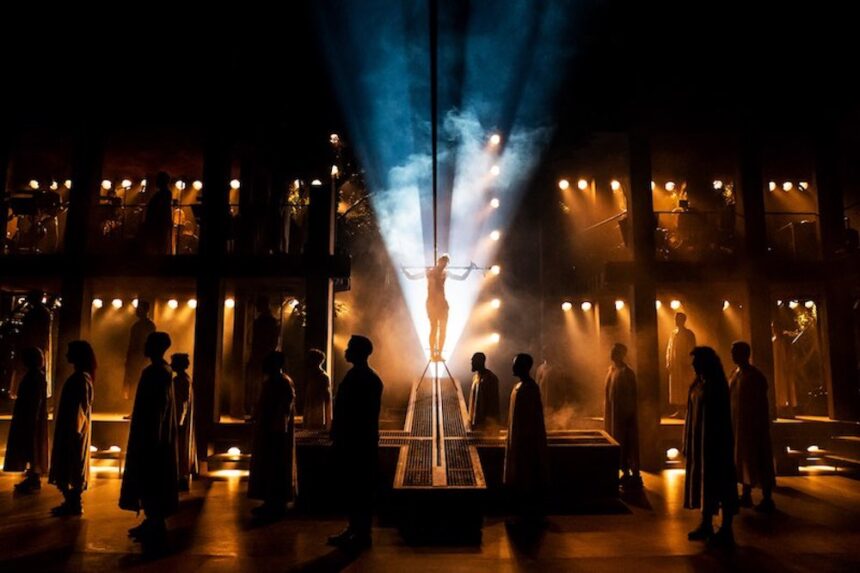(Scene from Jesus Christ Superstar. Image source: Austin Chronicle)
Historians and theologians have long debated the question of who killed Jesus and why. The narrative of Jesus’ crucifixion is a controversial topic that has persisted for centuries. Two Broadway musicals, Godspell and Jesus Christ Superstar, offer contrasting views on the events leading to Jesus’ death, reflecting different interpretations of his message, his relationship with the Jewish community, and the reasons behind his execution.
Portrayals of Jesus’ death have a complex history, often leading to anti-Jewish sentiments and contributing to discrimination. The dramatization of the gospel story has historically demonized Jewish people and incited violence against them. However, the representations of Jesus in Godspell and Superstar present unique perspectives that challenge traditional narratives and offer a more responsible approach to describing Jesus’ death.
Jesus Takes the Stage
Despite their similarities, Godspell and Jesus Christ Superstar present vastly different portrayals of Jesus. While both musicals emerged in the early 1970s and share certain stylistic elements, their interpretations of Jesus’ character diverge significantly. The Jesus of Superstar is depicted as somber, troubled, and misunderstood, while the Jesus of Godspell exudes joy and playfulness.
The Philosopher Jesus of Godspell
Godspell presents Jesus as a philosopher, a teacher of wisdom and love. The musical incorporates various parables and sermons from the gospels, emphasizing the message of love and unity. Jesus’ character in Godspell exudes joy and positivity, spreading his message of love to all.

(Scene from Godspell. Image source: Arts & Faith Magazine)
In contrast to the joyful depiction of Jesus in Godspell, the film represents Jesus’ opponents as a giant, robotic figure, creating a stark contrast between love and opposition in the narrative.
After a brief exchange borrowed from the gospels, Jesus starts to sing “Alas for You.”
“Alas, alas for you,
Lawyers and Pharisees,
Hypocrites that you be.”
In “Godspell,” it is suggested that Jewish opposition to Jesus is purely hypocritical, without any substantial disagreement or political context. The portrayal of Jewish resistance to Jesus is painted as malicious rather than rooted in any genuine conflict. The crucifixion scene in the musical places the blame for Jesus’ death solely on the Jewish people, with no mention of Rome’s involvement.
The Roman occupation is briefly acknowledged in the musical, with Jesus approving the payment of taxes to Caesar. However, the overall portrayal of Jesus in “Godspell” is apolitical and focused on individual salvation rather than social change. The lack of emphasis on any impending judgment or coming kingdom further reinforces the apolitical nature of the Jesus portrayed in the musical.
The depiction of Jesus in “Godspell” aligns closely with the Sapiential Jesus model popularized by scholars in the late 20th century, emphasizing Jesus as a teacher of wisdom and love. This portrayal sets Jewish legalism against Jesus’ message of compassion, similar to the way the musical portrays Jewish opposition to Jesus.
In contrast, “Jesus Christ Superstar” presents a different perspective on Jesus’ life and death. The musical establishes a conflict between the Jews and the occupying Roman army, with Jesus seen as a source of tension within this context. The songs in the musical highlight the desire for deliverance from Roman occupation, emphasizing the political implications of Jesus’ actions.
Overall, while “Godspell” portrays Jesus as apolitical and focused on individual salvation, “Jesus Christ Superstar” presents a more politically charged narrative, highlighting the tensions between the Jews and the Romans. Caiaphas disagrees with the notion that Jesus is just another scripture-thumping hack from Galilea. He believes that Jesus is important and could potentially start a major war. Caiaphas expresses his concerns about Jesus being called King and the implications it could have with the Romans and their people.
In “Superstar,” Jesus is portrayed as a figure on a collision course with the Roman state, much like Judas and the other disciples. The musical highlights the intra-Jewish conflict that arises, with Rome serving as the main threat.
The depiction of Jesus in “Superstar” shows him reacting to the aftermath of his preaching career. Although he says little of substance, the songs in the musical provide insight into Jesus’ message, which revolves around the idea of a kingdom and the liberation of Judea.
When questioned by Pilate, Jesus’s statements about being a king are ambiguous but suggest that he claims some form of kingship. This aligns with the Apocalyptic Jesus interpretation, which views Jesus as a prophet of God’s impending judgment.
Despite the anti-Jewish tropes present in “Superstar,” the musical effectively portrays the events leading to Jesus’ death within the political realities of first-century Judea. It emphasizes the role of the Romans in crucifying Jesus while giving sympathetic motives to his Jewish opposition.
Both “Superstar” and “Godspell” offer different portrayals of Jesus, with “Superstar” providing a more nuanced perspective on the events surrounding his death. While both musicals have their flaws in depicting ancient Jews and Judaism, there is a call for a new Jesus musical that avoids perpetuating Christian antisemitism. Could you please paraphrase this text?
Source link




